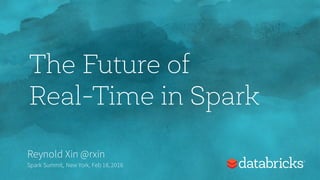
The Future of Real-Time in Spark
- 1. The Future of Real-Time in Spark Reynold Xin @rxin Spark Summit, New York, Feb 18,2016
- 2. Why Real-Time? Making decisions faster is valuable. • Preventingcreditcard fraud • Monitoringindustrialmachinery • Human-facingdashboards • …
- 3. Streaming Engine Noun. Takes an input streamand producesan output stream.
- 4. SQL Streaming MLlib Spark Core GraphX Spark Unified Stack
- 5. StreamingSQL MLlib Spark Core GraphXStreaming Introduced3 years ago in Spark 0.7 50% usersconsider most important part of Spark Spark Unified Stack
- 6. Spark Streaming • First attempt at unifying streaming and batch • State management built in • Exactly once semantics • Features required for large clusters • Straggler mitigation,dynamic load balancing,fast fault-recovery
- 7. Streaming computations don’t run in isolation.
- 8. Use Case: Fraud Detection STREAM ANOMALY Machine learningmodel continuously updates to detectnew anomalies Ad-hocanalyze historic data
- 9. Continuous Application noun. An end-to-end application that acts on real-time data.
- 10. Challenges Building Continuous Applications Integration with non-streaming systems often an after-thought • Interactive,batch,relational databases, machine learning,… Streaming programming models are complex
- 11. Integration Example Streaming engine Stream (home.html, 10:08) (product.html, 10:09) (home.html, 10:10) . . . What can go wrong? • Late events • Partial outputs to MySQL • State recovery on failure • Distributed reads/writes • ... MySQL Page Minute Visits home 10:09 21 pricing 10:10 30 ... ... ...
- 12. Processing Businesslogic change & new ops (windows,sessions) Complex Programming Models Output How do we define outputover time & correctness? Data Late arrival, varying distribution overtime, …
- 14. The simplest way to perform streaming analytics is not having to reason about streaming.
- 15. Spark 2.0 Infinite DataFrames Spark 1.3 Static DataFrames Single API !
- 16. Structured Streaming High-level streaming API built on SparkSQL engine • Runsthe same querieson DataFrames • Eventtime, windowing,sessions,sources& sinks Unifies streaming, interactive and batch queries • Aggregate data in a stream, then serve using JDBC • Change queriesatruntime • Build and apply ML models
- 17. output for data at 1 Result Query Time data up to PT 1 Input complete output Output 1 2 3 Trigger: every 1 sec data up to PT 2 output for data at 2 data up to PT 3 output for data at 3 Model
- 18. delta output output for data at 1 Result Query Time data up to PT 2 data up to PT 3 data up to PT 1 Input output for data at 2 output for data at 3 Output 1 2 3 Trigger: every 1 sec Model
- 19. Model Details Input sources:append-onlytables Queries: newoperators for windowing, sessions, etc Triggers:based on time (e.g. every 1 sec) Output modes: complete, deltas, update-in-place
- 20. Example: ETL Input: files in S3 Query: map (transform each record) Trigger: “every5 sec” Output mode: “newrecords”,into S3 sink
- 21. Example: Page View Count Input: recordsin Kafka Query: select count(*) group by page, minute(evtime) Trigger: “every5 sec” Output mode: “update-in-place”, into MySQL sink Note: this will automatically update “old” recordson late data!
- 22. Logically: DataFrame operations on static data (i.e. as easyto understand as batch) Physically: Spark automatically runs the queryin streaming fashion (i.e. incrementally and continuously) DataFrame Logical Plan Continuous, incremental execution Catalyst optimizer Execution
- 23. logs = ctx.read.format("json").open("s3://logs") logs.groupBy(logs.user_id).agg(sum(logs.time)) .write.format("jdbc") .save("jdbc:mysql//...") Example: Batch Aggregation
- 24. logs = ctx.read.format("json").stream("s3://logs") logs.groupBy(logs.user_id).agg(sum(logs.time)) .write.format("jdbc") .stream("jdbc:mysql//...") Example: Continuous Aggregation
- 25. T = 0 Aggregate AggregateT = 1 AggregateT = 2 … Automatic Incremental Execution
- 26. Rest of Spark will follow • Interactive queriesshould just work • Spark’s data sourceAPI will be updated to support seamless streaming integration • Exactly once semantics end-to-end • Different outputmodes (complete,delta, update-in-place) • ML algorithms will be updated too
- 27. What can we do with this that’s hard with other engines? Ad-hoc, interactive queries Dynamic changing queries Benefits of Spark: elastic scaling, stragglermitigation, etc
- 28. Use Case: Fraud Detection STREAM ANOMALY Machine LearningModel continuously updates to detectnew anomalies Analyze Historic Data
- 29. Timeline Spark 2.0 • API foundation • Kafka, file systems, and databases • Event-time aggregations Spark 2.1 + • Continuous SQL • BI app integration • Other streaming sources/ sinks • Machine learning
- 30. Thank you. @rxin